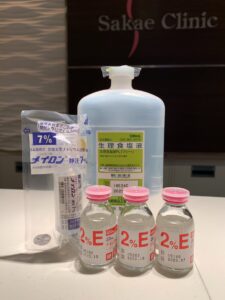2021/11/26
Anesthesia for mole removal
- mole treatment, Mole treatment, Mole eraser, Mole removal, mole anesthesia, Mole treatment, Mole eraser, Mole removal, Laser treatment, Cosmetic Surgery, Kuroko, Mole treatment, Kuroko eraser, Mole removal

Reading Time: <1 minuteMany patients come to our clinic requesting mole removal.In addition to the scar after mole removal, everyone is concerned about the pain during treatment and the pain of anesthesia.For mole removal, a local anesthetic is administered.In particular, men are more vulnerable to pain than women, so we manufacture local anesthetics in-house to reduce pain during anesthesia as much as possible.Generally, the local anesthetic is performed by injecting a drug called lidocaine hydrochloride, which is called xylocaine, into the mole removal site with a syringe.Most of the concentrations of xylocaine used in cosmetic surgery are XNUMX%, XNUMX%, and XNUMX%. It seems that the pain caused by the local anesthetic is very strong.At our hospital, we adjust the concentration of xylocaine, which contains a vasoconstrictor called epirenamin, to be diluted to about XNUMX%.The local anesthetic is adjusted to be neutral so that the pH of the local anesthetic is close to the pH of the living body by mixing Meiron, a bicarbonate with an alkaline pH.This greatly reduces pain during local anesthesia.Unfortunately, the knowledge of how to adjust local anesthetics is still not widespread among many cosmetic surgeons.All the cosmetic surgeons and cosmetic dermatologists I have instructed do not use local anesthetics as they are, but use Meiron to adjust the pH and dilute the concentration.Also, the thicker the injection needle, the more painful it will be when it penetrates the skin.Anesthesia is performed using ultra-thin needles of XNUMXG to XNUMXG depending on the area, so pain is significantly reduced compared to receiving local anesthesia with normal thick needles.It is also important in medical practice to consider the anesthesia method and drugs used during the procedure.Self-funded medical treatment requires advanced knowledge, skills, and delicate consideration.When removing moles for cosmetic purposes, we believe that it is essential for patients to receive the best cosmetic medical services.If you are still afraid of injecting anesthetic into your face, use a small medical vibrator or vibration oscillator that vibrates at a high speed and bring it into contact with the skin near the injection site to cause pain. Special anesthetic techniques can be performed to lower the threshold.


2021/11/24
Mole removal Care based on wound healing theory
- mole, Mole eraser, Mole removal, Hollow Poppy, Mole, Mole treatment, Mole removal, Carbon dioxide laser, Kuroko, Mole treatment, Kuroko eraser, Mole removal
Reading Time: <1 minuteCare after mole removal is more important than the mole removal procedure.The wound will begin to heal immediately after the mole is removed.If proper care is not taken at this time, not only will healing be delayed, but scarring will likely remain.Care is required immediately after treatment, that is, immediately after mole removal.Specifically, never disinfect the wound.Do not let dry.Never apply cream-based ointments.is.Many patients receive mole removal at our clinic, but we always provide detailed explanations of the care to be taken after mole removal and carefully instruct patients to perform the procedure themselves.Wounds after mole removal are treated in the same manner as abrasions and burns.Disinfection is not only completely pointless, but also prolongs healing.Disinfection destroys the cells that promote healing.Disinfecting can also make you more susceptible to infection.At our hospital, after removing a mole, we always apply a medical wound dressing to protect the scar, and at the same time, we use moist therapy to keep the wound wet.This promotes granulation and epithelial formation.This leads to mole scars becoming less noticeable.Removing a mole means creating skin that lacks epithelium.If you protect this area and encourage epithelial formation as soon as possible, there will be no risk of infection, normal healing will be promoted, and scars will be less likely to remain.When removing a mole with a carbon dioxide laser, it is assumed that a burn has occurred and care is required after the mole is removed.The thermal energy of the carbon dioxide laser evaporates the mole tissue, but it also causes thermal damage to normal skin, causing burns.For this reason, wounds after mole removal heal more slowly than simple abrasions. You can leave the medical dressing on for XNUMX days. After XNUMX days have passed, you will be asked to remove the dressing yourself and wash the wound with tap water or a shower.Bacteria that can cause infection, such as grime and sweat, are also washed away.After that, you can apply a medical wound dressing or a commercially available wound power pad for another XNUMX days to complete healing.
https://www.sakae-clinic.com/wound/p01.html?_ga=2.16767669.22389379.1637503973-1223386255.1510898913
Epithelialization on the face, which has good blood flow, can be completed after a few days of application, but on the body and extremities, especially the legs and back, blood flow is poor and epithelialization often does not occur even for a week, so it is not recommended to use the wound dressing for a long period of time. In order to delay the healing of the wound, even if it is a little sticky, you may dry it and wait for it to heal. Redness will remain for about XNUMX months, so avoid direct exposure to UV rays on the area where the mole was removed.If epithelialization is not completed when exposed to ultraviolet rays, pigmentation may occur.There is no need to take antibiotics unless there is an emergency.
2021/11/17
Care after removing moles
- mole, Mole excision, Mole treatment, Mole eraser, Mole removal, Mole, Mole excision, Mole treatment, Mole removal, Kuroko, Mole excision, Mole treatment, Kuroko eraser, Mole removal
Reading Time: <1 minuteMore important in mole treatment is post-treatment care than removal.No matter how clean it is removed, if care for the scars after removal of the mole is inadequate or inappropriate, there is an increased risk of scars remaining after removal.Whether it is excised, removed with a carbon dioxide laser, or removed with a high-frequency evaporation method, scratches will always occur after removing the mole.Proper care of this wound is important as it will determine if you are satisfied or unsatisfied as a result of the final mole removal.Cleanly remove moles with a carbon dioxide laser! !!I've seen an advertisement saying, is that true?Can a laser remove it cleanly?That's a pretty overstated expression.Selectively remove and eliminate pigment cells.This is the ultimate mole removal secret.A flat mole with a pigment in the deep part of the dermis. A mole called melanocytic nevus is more difficult to completely remove and has a higher recurrence rate than a raised mole.Removing with a carbon dioxide laser means that heat is concentrated on the mole tissue and the heat energy is used to evaporate the mole tissue.Since the constituents of moles can be considered to be equivalent to those of living organisms, it is assumed that they are roughly composed of XNUMX% water and XNUMX% protein.When heat is applied to this tissue, the part of the skin that comes into contact with the heat naturally becomes a burn.If the burn is in the shallow part of the dermis, granulation does not occur and epithelialization occurs rapidly, leaving almost no scars and healing.The important point of care after removing moles is how quickly care is taken to promote this epithelialization.The latest wound healing theory recommends care with hydrocolloid dressing that does not dry the wound.Naturally, disinfection of the wound is contraindicated.It is better to clean the wound every day.At our hospital, after removing the mole, a medical wound dressing is applied to the wound after applying an antibiotic ointment.Leave it as it is for XNUMX days in this state.Assuming that epithelialization progresses, after XNUMX days, remove the wound dressing and wash the wound with a shower, and then apply the wound dressing for another XNUMX days.This first care becomes very important in the process of healing the wound.Unlike the face, scars on the back and upper limbs after removing moles are significantly delayed in healing.In particular, the lower limbs need a period of time to heal more than three times as much as the face and the redness disappears.The wound process differs depending on the part of the body.From experience, the specialist understands which part of the scar heals faster or slower and gives guidance on its care.
https://www.sakae-clinic.com/wound/
Mole scar care is important because it is a scar specialist.
2021/11/16
Anesthesia for mole removal
- mole, Mole excision, mole removal, Mole treatment, Mole eraser, Mole removal, Mole, Mole excision, Mole removal, Mole treatment, Mole eraser, Mole removal, Laser treatment, Kuroko, Mole excision, Kuroko-tori, Mole treatment, Kuroko eraser, Mole removal
Reading Time: <1 minuteIn principle, the anesthetic used for mole removal is lidocaine hydrochloride, or xylocaine. https://www.kegg.jp/medicus-bin/japic_med_product?id=00000332-003is used.Xylocaine, which contains a vasoconstrictor called epirenamin, is used.Epilenamine has the effect of constricting blood vessels to control bleeding and prolonging the effective time of her xylocaine during treatment.Medical school textbooks state that it is contraindicated for use on the tip of the nose and fingertips, but currently clinically there are almost no problems. (It was thought that skin necrosis may occur due to vasoconstriction.) Concentrations of XNUMX% to XNUMX% formulations are often used. XNUMX% is a sufficient concentration and there is no problem in use.At our hospital, we use xylocaine, but as the name of xylocaine lidocaine hydrochloride suggests, it has an acidic PH of XNUMX to XNUMX. It causes sexual pain.For this reason, in order to adjust the pH, he mixes an alkaline agent called Meiron to further lower the concentration, and he adjusts the pH to about XNUMX, which is as close to the living body as possible.In actual use, compared to traditional Xylocaine injections, he was far less painful and less burdensome on the patient.Also, the needle used for the injection is XNUMXG to XNUMXG, which reduces the pain considerably.When removing a large number of moles, injections are required for the number of moles, so pain relief care is always required during anesthesia for the patient.Even if the amount of anesthesia required for mole removal is small and simple, pain can be alleviated with careful injections.At our hospital, we remove moles by using ultra-fine needles and using our own PH-adjusted xylocaine anesthetic.



